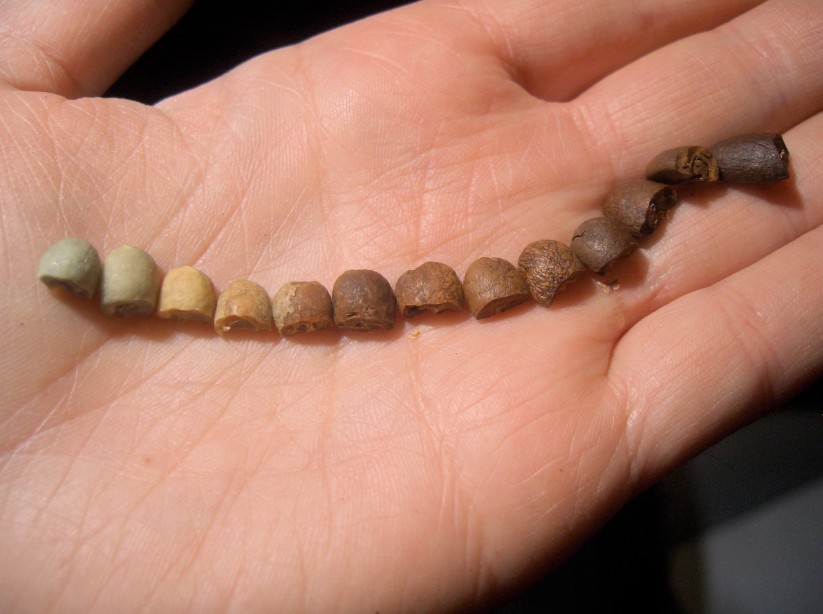Correctly and quickly select fresh coffee beans to smell, see, peel and taste
Many friends left messages that they would not choose coffee beans, or did not know how to tell whether the coffee beans they bought were fresh or not. Today, the barista barista training class in Chongqing just talked about how to select coffee beans. The next time you buy coffee, you will not be afraid to buy bad and bad coffee beans. Next, let's take a look at the four basic steps we need to know about selecting coffee beans: smell, see, peel, and taste.

Let's explain one by one how to judge the quality of coffee beans through the above four steps.
1. Smell
If you smell a strong aroma, the coffee bean is fresh enough; if the aroma is weak or even greasy, it means that the coffee bean is no longer fresh.
Please note that by greasy taste, I mean smell, not shape, otherwise the deeply roasted coffee beans are all oily, and they will not be fresh.
When we go to buy coffee beans, what we come into contact with is usually packaged. We can only squeeze the one-way exhaust valve and smell whether the aroma is strong enough.
two。 Look.
The quality of coffee beans is examined from the point of view of shape, color, size and so on.
First of all, the shape is required to be complete, and the presence of defective beans will affect the taste of coffee.
Which beans are defective beans? What are the causes of each?
Round beans. As mentioned in the previous coffee quiz, a round bean is a coffee fruit with only one round seed, which is caused by the environment in which the coffee tree grows. When the number of round beans is relatively small, it does not affect the taste of coffee.
Black beans. Premature coffee beans fall to the ground before picking and are easy to ferment into black beans, which are easier to pick out.
Pest beans. It is caused by worms drilling into the coffee fruit to lay eggs.
Shell beans. Caused by improper handling in the drying process.
Broken beans. Produced when shelling and pulp are removed by a machine.
Stunted beans. The climatic conditions, rainfall and soil nutrition of coffee-growing countries will affect the growth of raw coffee beans. When nutrients are insufficient, it is easy to produce stunted coffee beans.
Other causes of defective beans:
When using the sun treatment, if you encounter rainy weather, or use a rake to turn the coffee beans are not timely and uneven are easy to produce dried beans and moldy beans.
In the process of transportation and storage, mildew beans will also be caused if the environment is too wet.
Using water washing treatment, if the sink is not clean, fermented beans will be produced, the effect of fermented beans is much worse than other defective beans, because it will also make good coffee beans stink, "a grain of mouse shit destroys a pot of porridge" is it.
Secondly, look at the color. Different coffee beans are suitable for different roasting degrees, and Italian coffee is the darkest (or most roasted) coffee, followed by Mantenin, Brazil, Colombia and Mocha. Coffee beans from the same origin should be roughly the same color, otherwise it means that the roasting is not uniform enough.
Finally, look at the size. All kinds of coffee beans are of different sizes, including the big Blue Mountain Coffee and the petite Yunnan small Coffee. It is difficult to compare the coffee from different places, but in the coffee from the same origin, we still take a big and full coffee as the best.
3. Peel off
Peel the coffee beans by hand, if they can be easily peeled off and feel crisp, then the coffee beans are very fresh. If they are old beans, it takes a lot of effort to peel them off.
In addition, after peeling, if the color of the outer skin of the bean is the same as that of the inner layer, it means that the firepower is uniform when baking; if the surface color is much darker than the inner layer, it means that there is too much firepower when baking.
4. Taste
Nibble coffee beans, if they feel crisp, it means coffee beans are fresh.
Through the above steps, you should be able to choose good, fresh coffee beans very smoothly.
Important Notice :
前街咖啡 FrontStreet Coffee has moved to new addredd:
FrontStreet Coffee Address: 315,Donghua East Road,GuangZhou
Tel:020 38364473
- Prev

How to clean the brewing head of the coffee maker regularly? How to disassemble the coffee machine
One of the questions often asked in the coffee industry is how often should I clean the coffee machine? The answers are varied, some say once a day, others say once a week, and still others say according to the amount of coffee. But does anyone really know the answer to this question? None of these answers is supported by public research. In order to answer this question, the author conducted an experiment to study the meaning.
- Next

Barista's five innovative inventions-Piccolo latte
With the popularity of Flat White coffee all over the world, today Chongqing Brista Coffee West Point training School has come to share with friends the coffee culture from Australia. Australia's contribution to the coffee industry in addition to Flat White coffee is actually a lot that we do not know. Australians are deeply influenced by the traditional Italian coffee culture and the New World Coffee text created by Anglou Saxon.
Related
- Detailed explanation of Jadeite planting Land in Panamanian Jadeite Manor introduction to the grading system of Jadeite competitive bidding, Red bid, Green bid and Rose Summer
- Story of Coffee planting in Brenka region of Costa Rica Stonehenge Manor anaerobic heavy honey treatment of flavor mouth
- What's on the barrel of Blue Mountain Coffee beans?
- Can American coffee also pull flowers? How to use hot American style to pull out a good-looking pattern?
- Can you make a cold extract with coffee beans? What is the right proportion for cold-extracted coffee formula?
- Indonesian PWN Gold Mandrine Coffee Origin Features Flavor How to Chong? Mandolin coffee is American.
- A brief introduction to the flavor characteristics of Brazilian yellow bourbon coffee beans
- What is the effect of different water quality on the flavor of cold-extracted coffee? What kind of water is best for brewing coffee?
- Why do you think of Rose Summer whenever you mention Panamanian coffee?
- Introduction to the characteristics of authentic blue mountain coffee bean producing areas? What is the CIB Coffee Authority in Jamaica?

